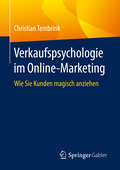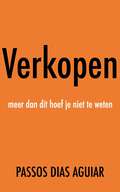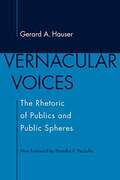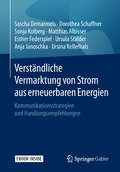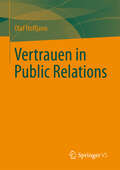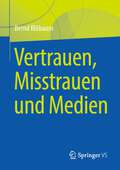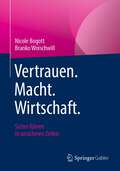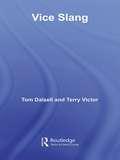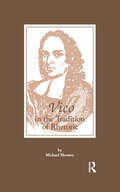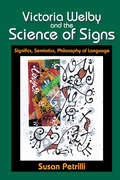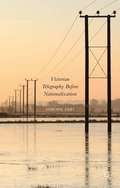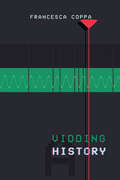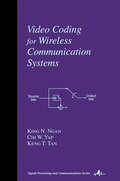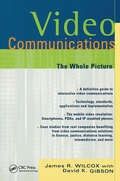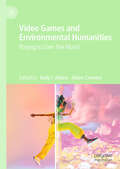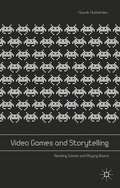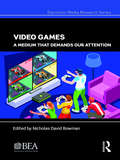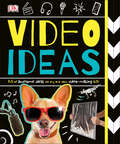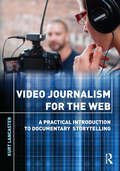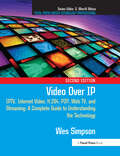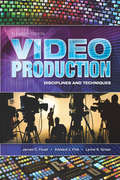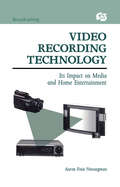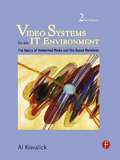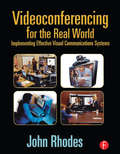- Table View
- List View
Verkaufspsychologie im Online-Marketing: Wie Sie Kunden magisch anziehen
by Christian TembrinkKaufentscheidungen im Internet laufen selten rational ab: Auch online steuern Emotionen und unterbewusste Prozesse unsere Entscheidungsfindung, und häufig können wir nicht genau sagen, warum wir etwas gekauft haben. Dieses Buch erklärt kompakt und auf den Punkt, wie Unternehmen verkaufspsychologische Techniken im digitalen Marketing für sich nutzen und gewinnbringend anwenden können. Denn wer die unbewussten Wahrnehmungsprozesse seiner Kunden im Kern trifft, kann auch mit knappen Ressourcen gute Resultate erzielen und Umsätze erheblich steigern.Lernen Sie, wie Sie Emotionen ansprechen, damit Ihre digitalen Besucher zu echten, zufriedenen Befürwortern Ihrer Marke und Produkte werden. Lassen Sie sich von einer Kombination aus wissenschaftlichen Grundlagen und praktischen Beispielen inspirieren, um auch Ihre Web-Inhalte durch psychologische Strategien aufzuwerten – alles mit dem klaren Ziel: die digitale Kontaktqualität und den Erlebniswert Ihrer Inhalte zu maximieren.
Verkopen: meer dan dit hoef je niet te weten
by Passos Dias AguiarSlim en lui zijn verkoopt als een gek Als je wilt weten hoe je wat dan ook aan wie dan ook verkoopt en alleen dat wilt doen wat echt werkt en de rest aan anderen wilt overlaten, dan is dit boek iets voor jou. Deze beknopte gids richt zich op bewezen concepten en hulpmiddelen die elke verkoper nodig heeft. Met dit boek ontwikkel je deze verkoopvaardigheden en leert ze aan te scherpen. De matrix van Von Manstein, een hulpmiddel om toppresteerders te onderscheiden, bedacht door het militaire genie veldmaarschalk Erich Von Manstein, legt uit waarom slim en lui zijn de juiste keuze is. Slimme en luie mensen denken na voordat ze handelen, vermijden onproductieve dingen, focussen op een de prioriteiten en weten wat ze niet moeten doen. Waarom zou je je tijd verspillen aan het leren van 365 manieren om met bezwaren om te gaan, als het beheersen van een handjevol daarvan voor 80% van de situaties voldoende is? Verkopen gaat over 7 grondbeginselen: •Zelfbeeld •Doelen •Afspraken maken •Relaties opbouwen •Verleidelijke presentaties •Omgaan met bezwaren •De deal afsluiten Het boek laat een aantal effectieve technieken zien om deze zeven grondbeginselen onder de knie te krijgen, of je nou begint in de verkoop, het klappen van de zweep al kent, of ergens tussenin zit. Meer hoef je eigenlijk niet te weten om succesvol te zijn in de verkoop. Doe jezelf een plezier en pak dit boek en ga lezen!
Vernacular Translation in Dante's Italy: Illiterate Literature
by Alison CornishTranslation and commentary are often associated with institutions and patronage; but in Italy around the time of Dante, widespread vernacular translation was mostly on the spontaneous initiative of individuals. While Dante is usually the starting point for histories of vernacular translation in Europe, this book demonstrates that The Divine Comedy places itself in opposition to a vast vernacular literature already in circulation among its readers. Alison Cornish explores the anxiety of vernacularization as expressed by translators and contemporary authors, the prevalence of translation in religious experience, the role of scribal mediation, the influence of the Italian reception of French literature on that literature, and how translating into the vernacular became a project of nation-building only after its virtual demise during the Humanist period. Vernacular translation was a phenomenon with which all authors in thirteenth- and fourteenth-century Europe - from Brunetto Latini to Giovanni Boccaccio - had to contend.
Vernacular Voices: The Rhetoric of Publics and Public Spheres (Studies in Rhetoric & Communication)
by Gerard A. Hauser Phaedra C. PezzulloA foundational text of twenty-first-century rhetorical studies, Vernacular Voices addresses the role of citizen voices in steering a democracy through an examination of the rhetoric of publics. Gerard A. Hauser maintains that the interaction between everyday and official discourse discloses how active members of a complex society discover and clarify their shared interests and engage in exchanges that shape their opinions on issues of common interest. <p><p> In the two decades since Vernacular Voices was first published, much has changed: in the aftermath of the 9/11 terrorist attacks, US presidents have increasingly taken unilateral power to act; the internet and new media have blossomed; and globalization has raised challenges to the autonomy of nation states. In a new preface, Hauser shows how, in an era of shared, global crises, we understand publics, how public spheres form and function, and the possibilities for vernacular expressions of public opinion lie at the core of lived democracy. A foreword is provided by Phaedra C. Pezzullo, associate professor of communication at the University of Colorado Boulder.
Verständliche Vermarktung von Strom aus erneuerbaren Energien
by Sascha Demarmels Dorothea Schaffner Sonja Kolberg Matthias Albisser Esther Federspiel Ursula Stalder Anja Janoschka Ursina KellerhalsDieses Buch untersucht, wie sich Stromprodukte aus erneuerbaren Energien verständlich vermarkten lassen, sodass die Konsumentinnen und Konsumenten den Mehrwert dieser Produkte verstehen und eine informierte Kaufentscheidung treffen. Eine Toolbox liefert Handlungsempfehlungen und erläutert Kommunikationsstrategien wie Gamification, Storytelling, Vereinfachung und Visualisierung. Basis der Handlungsempfehlungen sind Experteninterviews, in Experimenten getestete Pilotbeispiele sowie von Partnerunternehmen entwickelte Kommunikationsbeispiele, die in der Praxis umgesetzt und als Feldexperiment geprüft wurden.Der InhaltStrommarkt und -marketing in den DACH LändernForschungsstand "Angewandte Verständlichkeit"Kommunikationsstrategien zur Steigerung der Verarbeitungsmotivation und deren ValidierungBest-Practice-Beispiele aus verschiedenen Ländern Toolbox.
Vertrauen in Public Relations
by Olaf HoffjannPR ist für viele längst zum Inbegriff der scheinheiligen Lüge geworden. Zu Recht - wie die Greenwashing-Strategien von Energiekonzernen eindrucksvoll zu belegen scheinen. Oder tut man ihr doch Unrecht? Denn wie soll PR in einer Kontingenzgesellschaft noch Wahrhaftigkeit und Redlichkeit beweisen können? Dieses Spannungsfeld steht im Mittelpunkt des Buches: Im ersten Teil werden Vertrauen bzw. Vertrauenswürdigkeit als zentrale Kategorien der PR herausgearbeitet. Worin besteht das Vertrauen in PR? Wie wird Vertrauen in PR begründet? Im zweiten Teil wird untersucht, wie PR das Problem der Vertrauenswürdigkeit zwischen Lüge und Wahrhaftigkeit sowie zwischen egoistischem und selbstlosem Verhalten zu lösen versucht. Auf einer systemtheoretischen und non-dualistischen Basis wird eine Gratwanderung unternommen: Es soll weder ein Whitewashing noch eine Verdammung der PR betrieben werden. Und doch wird am Ende des Buches immer deutlicher, wie schwierig es für den "Ehrlichen" ist, die Öffentlichkeit von seiner Redlichkeit zu überzeugen - und welche Chancen genau darin für die "Unehrlichen" liegen.
Vertrauen, Misstrauen und Medien
by Bernd BlöbaumVertrauen ist im sozialen Leben und in der Gesellschaft eine wichtige Ressource und Produktivkraft. Das Buch beschreibt in einem konzeptionellen Teil wie sich Vertrauen entwickelt, wie es definiert werden kann und aus welchen Elementen sich ein Vertrauensprozess zusammensetzt. Vorgestellt werden ein Vertrauensmodell sowie Wege, Vertrauen und Misstrauen empirisch zu erforschen. Im empirischen Teil werden Daten aus eigenen repräsentativen Befragungen präsentiert. Dabei werden vertrauensvolle und misstrauische Menschen charakterisiert. Ausführlich werden Medien und Journalismus als Objekte von Vertrauen, Skepsis und Misstrauen behandelt. Dargestellt wird, welche Rolle Medien und Journalismus bei Vertrauen in Politik, Wissenschaft und Religion spielen, bevor bilanzierend reflektiert wird, wie Vertrauen geschaffen und Misstrauen vermieden werden kann.
Vertrauen. Macht. Wirtschaft.: Sicher führen in unsicheren Zeiten
by Branko Woischwill Nicole BogottFür eine florierende Wirtschaft sind vertrauensvolle Interaktionen elementar: Wirtschaft bedeutet Beziehungsarbeit. Dieses Buch untersucht die Frage, wie eine nachhaltige Vertrauenskultur Macht aufbauen, gestalten und vertiefen kann. Das Power Triangle®-Modell zeigt Führungskräften, wie sie mithilfe von Netzwerken, Ressourcen und Wissen Macht beeinflussen. Neben fundierten Analysen präsentieren Bogott und Woischwill praxisorientierte Handlungsvorschläge. In 21 Interviews kommen Expert:innen global agierender Konzerne wie Coca-Cola, Henkel, Porsche und SAP mit ihren Erfahrungen und Konzepten zu Wort, darunter Leo Hoffmann-Axthelm, Gründungsmitglied von ICAN, Träger des Friedensnobelpreises. – Mit einem Geleitwort der Investorin und Bundestagsabgeordneten a.D. Dagmar Wöhrl.
Vice Slang
by Tom Dalzell Terry VictorAre you a bit of a chairwarmer? Do you use the wins from a country straight to get scudded on snakebite in a blind tiger? Do you ride the waves on puddle or death drop? Vice Slang gently eases you into the language of gambling, drugs and alcohol, providing you with 3,000 words to establish yourself firmly in the world of corruption and wickedness. All words are illustrated by a reference from a variety of sources to prove their existence in alleys and dives throughout the English speaking world. This entertaining book will give you hours of reading pleasure.
Vico in the Tradition of Rhetoric
by Michael MooneyIf among the many truths of Giambattista Vico's New Science there is one that is deepest, it is the truth that language, mind, and society are but three modes of a common reality. In Vico's term, that reality is the monde civile, the world of man. It is a world of many guises and faces. If reflected in a mirror, those faces would reveal an image of the full array of contemporary arts and sciences, all the disciplines of learning and technique by which, so Vico judged, humanity attains its perfection. Humanity in its perfection, however, is so rare a moment, so delicate and subtle a state, that it is never to be found among the nations of the world -- or is found in so fragile a form that it threatens always to crack and fall to the ground. In the West, a persistent line of thinking that has flourished from time to time holds that language is primary in culture, metaphor a necessity, and jurisprudence our highest achievement. This was the position of Vico, who not only received and cherished the tradition, but looked deeply into it, saw what its principles implied, and so made ready for the great social theorists of the nineteenth century. That is the thesis of this work. After an introductory chapter on Vico himself -- in which his intellectual world and his movements within it are sketched -- the work unfolds in three parts. These parts successively treat rhetoric, pedagogy, and culture, each proceeding from a major Vichian text.
Victoria Welby and the Science of Signs: Significs, Semiotics, Philosophy of Language
by Susan PetrilliVictoria Welby (1837–1912) dedicated her research to the relationship between signs and values. She exchanged ideas with important exponents of the language and sign sciences, such as Charles S. Peirce and Charles S. Ogden. She examined themes she believed crucially important both in the use of signs and in reflection on signs. But Welby's research can also be understood in ideal dialogue with authors she could never have met in real life, such as Mikhail Bakhtin, Susanne Langer, and Genevieve Vaughan.Welby contends that signifying cannot be constrained to any one system, type of sign, language, field of discourse, or area of experience. On the contrary, it is ever more developed, enhanced, and rigorous, the more it develops across different fields, disciplines, and areas of experience. For example, to understand meaning, Welby evidences the advantage of translating it into another word even from the same language or resorting to metaphor to express what would otherwise be difficult to conceive.Welby aims for full awareness of the expressive potential of signifying resources. Her reflections make an important contribution to problems connected with communication, expression, interpretation, translation, and creativity.
Victorian Telegraphy Before Nationalization
by Simone FariVictorian Telegraphy Before Nationalization.
Vidding: A History
by Francesca CoppaVidding is a well-established remix practice where fans edit an existing film, music video, TV show, or other performance and set it to music of their choosing. Vids emerged forty years ago as a complicated technological feat involving capturing footage from TV with a VCR and syncing with music—and their makers and consumers were almost exclusively women, many of them queer women. The technological challenges of doing this kind of work in the 1970s and 1980s when vidding began gave rise to a rich culture of collective work, as well as conventions of creators who gathered to share new work and new techniques. While the rise of personal digital technology eventually democratized the tools vidders use, the collective aspect of the culture grew even stronger with the advent of YouTube, Vimeo, and other channels for sharing work. Vidding: A History emphasizes vidding as a critical, feminist form of fan practice. Working outward from interviews, VHS liner notes, convention programs, and mailing list archives, Coppa offers a rich history of vidding communities as they evolved from the 1970s through to the present. Built with the classroom in mind, the open-access electronic version of this book includes over one-hundred vids and an appendix that includes additional close readings of vids.
Video Coding for Wireless Communication Systems (Signal Processing and Communications)
by King N. Ngan Chi W. Yap Keng T. Tan"Explains the transmission of image and video information over wireless channels. Describes MPEG-4, the latest video coding standard. Discusses error resilient combined source channel image and video coders, and multiple access spread spectrum and future generation wireless video communication systems."
Video Communications: The Whole Picture
by David Gibson James WilcoxCase studies document how, in businesses all across this country, people are communicating via videoconferences with broadcast quality reception. The authors detail how the proliferation of IP networks has driven quality improvements and cost savings in
Video Games and Environmental Humanities: Playing to Save The World
by Adam Crowley Kelly I. AlianoThis edited collection investigates topics related to environmental humanities through their inclusion, exploration, or critique in contemporary video games. It focuses on how video games are a site for creating and interacting within environments, with analysis that showcases how environments are shaped within video games as well as serve as a reflection of our real world. This crossroad between the virtual and the real allows us to consider the ways in which the concepts, theories, and issues facing our real-world environment can be understood and studied through video games, particularly via the power of interactive play to teach. This book looks into how video games might empower their players to make real-world change through their immersive environments. Finally, the volume offers a consideration of ecological crises through an exploration of post-apocalyptic narratives in a wide variety of video games. This close textual analysis of video game narratives and play structures allows insight into how and why such stories were crafted and explores the various intersections between these fictional play environments and the conditions of our real world.
Video Games and Storytelling
by Souvik MukherjeeGrand Theft Auto IV saw more copies being sold than the latest superhero blockbusters or the last Harry Potter novel. Most of its players and critics commend its storytelling experience; however, when it comes to academic analysis, mainstream humanities research seems confused about what to do with such a phenomena. The problem is one of classification, in the first instance: 'is it a story, is it a game, or is it a machine?' Consequently, it also becomes a problem of methodology – which traditional discipline, if any, should lay claim to video game studies becoming the moot question. After weathering many controversies with regards to their cultural status, video games are now widely accepted as a new textual form that requires its own media-specific analysis. Despite the rapid rise in research and academic recognition, video game studies has seldom attempted to connect with older media and to locate itself within broader substantive discourses of the earlier and more established disciplines, especially those in the humanities. Video Games and Storytelling aims to readdress this gap and to bring video games to mainstream humanities research and teaching. In the process, it is also a rethinking story versus game debate as well as other key issues in game studies such as time, agency, involvement and textuality in video game-narratives.
Video Games: A Medium That Demands Our Attention (Electronic Media Research Series)
by Nicholas David BowmanThis entry in the BEA Electronic Media Research Series, born out of the April 2017 BEA Research Symposium, takes a look at video games, outlining the characteristics of them as cognitive, emotional, physical, and social demanding technologies, and introduces readers to current research on video games. The diverse array of contributors in this volume offer bleeding-edge perspectives on both current and emerging scholarship. The chapters here contain radical approaches that add to the literature on electronic media studies generally and video game studies specifically. By taking such a forward-looking approach, this volume aims to collect foundational writings for the future of gaming studies.
Video Ideas
by DKImagine and create awesome videos and animations to share with friends and family, and on YouTube, using phones, webcams, cameras, or camcorders.Inspirational and fun, this engaging book explores the video-making process from script to screen, with techniques to try out and practical tips to produce exciting projects at home. Discover how to get the best angles, lighting, and sound quality, and add special effects when recording using phone, webcam, camera, or camcorder. Turn footage into a finished product by adding visual effects with editing software, and find out how to format, upload, and create a trailer for the masterpiece. Whether you want to record special occasions, zany pets, action-packed sports events, a music video, or a stop-motion animation, Video Ideas has everything you need!The book's content supports the STEAM (Science, Technology, Engineering, Art, Math) approach to cross-curricular learning.
Video Journalism for the Web: A Practical Introduction to Documentary Storytelling
by Kurt LancasterAs newspapers and broadcast news outlets direct more resources toward online content, print reporters and photojournalists are picking up video cameras and crafting new kinds of stories with their lenses. Creating multimedia video journalism requires more than simply adapting traditional broadcast techniques: it calls for a new way of thinking about how people engage with the news and with emerging media technologies. In this guide, Kurt Lancaster teaches students and professional journalists how to shoot better video and tell better stories on the web, providing a strong understanding of cinematic storytelling and documentary production so their videos will stand out from the crowd. Video Journalism for the Web introduces students to all the basic skills and techniques of good video journalism and documentary storytelling, from shots and camera movements to sound and editing—as well as offering tips for developing compelling, character-driven narratives and using social media to launch a successful career as a "backpack journalist." Shooting, editing, and writing exercises throughout the book allow students to put these techniques into practice, and case studies and interviews with top documentary journalists provide real-world perspectives on a career in video journalism. This book gives aspiring documentary journalists the tools they need to get out in the field and start shooting unforgettable multimedia stories.
Video Over IP: IPTV, Internet Video, H.264, P2P, Web TV, and Streaming: A Complete Guide to Understanding the Technology (Fpmtp/focal Press Media Technology Professional Ser.)
by Wes SimpsonVideo Over IP gives you everything you need to know to choose from among the many ways of transferring your video over a network. The information is presented in an easy to read format, with comparison charts provided to help you understand the benefits and drawbacks of different technologies for a variety of practical applications. This new edition is expanded to fully cover HD and wireless technologies and new case studies.Whether your background is video, networking, broadcast, or telecommunications, you will benefit from the breadth of coverage that this book provides. Real-life application examples give readers successful examples of a variety of Video over IP networks that are up and running today.
Video Production: Disciplines and Techniques
by Edward J Fink James C Foust Lynne S GrossThis popular book introduces readers to the operations underlying video production. It provides thorough coverage of the theory readers need to know, balancing complexity with practical "how-to" information about detailed subjects, and it does so in a concise, conversational style. The authors have incorporated the major changes that have occurred in recent years; further increased the emphasis on digital, non-linear video production; updated and expanded information on mobile technologies; and added more than 25 new or updated figures. The subtitle remains "disciplines and techniques" because the book's focus continues to be on the fact that students need those foundations in order to be successful in video production, no matter where they may end up. Its affordable, student-friendly price, companion website, and print book and ebook options add to this book's practical nature.
Video Recording Technology: Its Impact on Media and Home Entertainment (Routledge Communication Series)
by Aaron Foisi NmungwunVideo recording has recently become an important phenomenon. Although the majority of American homes have at least one video recording set, not much is known about video recording's past and about its continual effect on affiliated industries. This text documents the history of magnetic recording, stressing its importance in consumer as well as commercial applications from the advent of magnetism through the invention of such new technologies as Digital Audio Tape (DAT), High Definition Television (HDTV), and a multitude of sophisicated Digital Video Cassette Recorders.
Video Systems in an IT Environment: The Basics of Professional Networked Media and File-based Workflows
by Al KovalickAudio/Video (AV) systems and Information Technology (IT) have collided. IT is being leveraged to create compelling networked media and file-based workflows. Video Systems in an IT Environment has helped thousands of professionals in broadcast, post and other media disciplines to understand the key aspects the AV/IT "tapeless" convergence. World-renowned educator and speaker Al Kovalick adds his conversational and witty style to this text making the book an enjoyable learning experience. Now in its second edition, this book includes: basics of networked media, storage systems for AV, MXF and other file formats, Web services and SOA, software platforms, 14 methods for high availability design, element management, security, AV technology, transition issues, real-world case studies and much more. Each chapter weaves together IT and AV techniques providing the reader with actionable information on the issues, best practices, processes and principles of seamless AV/IT systems integration.
Videoconferencing for the Real World: Implementing Effective Visual Communications Systems
by John Rhodes"John Rhodes' Videoconferencing for the Real World, is a one of the world's most comprehensive blueprints on the awesome power of videoconferencing."From the Foreword by Brad CaldwellChairman ICIA and President ofIntegrated Media Services, Anaheim, CADesigned to be useful to both technical and non-technical managers, Video-Conferencing for the Real World demystifies the subject of video communications. It provides easy-to-follow guidelines for deploying a cost-effective video-conferencing solution tailored to an organization's specific needs.Developed to flexible to the readers need, Video Conferencing for the Real World offers dynamic problem-solving techniques for the communication challenges facing managers today. Examining the technical, economic, and organizational aspects of each requirement and solution, this book offers a sound base of technical information and provides practical solutions based on a wealth of professional experience. Combining his own ideas with the input of system managers and users, service providers, consultants, and manufacturers, the author has developed a guide that will help readers make more informed investments of their time and money. Special attention is paid to conducting an effective needs analysis, and the development of solutions that will adapt easily to future changes in organizational requirements.Covering a variety of solutions, this book explores the advantages and disadvantages of desktop systems, set-top systems, rollabout systems, and room systems. In addition to compression, multipoint conferencing and data conferencing, this book also addresses topics such as, pilot projects, the preparation of RFPs, service contracts, training, content creation, and convergence.
